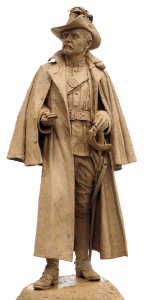 Wallendbeen born Major-General, the Honourable James Alexander Kenneth Mackay C.B., O.B.E., V.D., F.R.G.S. (1859-1935) is remembered for his actions in creating the Ist Australian Horse.
Wallendbeen born Major-General, the Honourable James Alexander Kenneth Mackay C.B., O.B.E., V.D., F.R.G.S. (1859-1935) is remembered for his actions in creating the Ist Australian Horse.
This regiment of cavalry volunteers was raised on August 30, 1897, with the initial call-up muster and enrolments taking place at Harden Murrumburrah.
The troop was the precursor to the Australian Light Horse and was recruited entirely from country districts in the NSW colony.
Detachments were also formed in Wallendbeen, Gundagai, Quirindi, Mudgee, Gunnedah, Scone, Braidwood, Lue, Bungendore and Cootamundra. Mackay was appointed to command the regiment in 1898 and was promoted Lieutenant-Colonel.
Recruits provided their own mounts and learned to fight with swords, carbines and lances during cavalry drills at regular training encampments.
Members of the regiment wore distinctive myrtle green uniforms with black embroidery. Their motto “For Hearths and Home” reflected Mackay’s belief that it was important for Australians to use their own resources to protect themselves.
When the Boer War broke out in 1899, the 1st Australian Horse sent two contingents to South Africa where they served as a cavalry squadron. Mackay was too senior in rank to accompany them. Resigning his portfolio, he was given command of the 6th Imperial Bushmen’s contingent of NSW, who were sent to Rhodesia, where he was mentioned in despatches. He also served in Mafikeng and Western Transvaal.
After Federation, Mackay’s vision for a unified Australian troop led to the creation of the Australian Light Horse in 1904, with the Ist Australian Horse and other mounted troops amalgamating into the new entity.
In 1912 McKay was given command of the 1st Light Horse Brigade, overseeing its reorganisation into the 3rd Australian Light Horse Brigade.
Mackay’s military service continued during WW1, where he was appointed to raise an Australian Army Reserve Force from returned soldiers. He was its first director-general from 1916. In 1920 he retired from military service with the rank of Major General.
Mackay was also a long serving state parliamentarian, entering the NSW State Legislative Assembly in 1895 as the member for Boorowa, which included the towns of Harden Murrumburrah.
As well as his military and parliamentary service, he is recognised as a visionary, bushman, poet, author and amateur jockey.
His political leadership, strategic vision and military expertise were all central to the success of the 1st Australian Horse.
There are many stories and legends about the Light Horse in Australian military history, from the Boer War, where the 1st Australian Horse contingents were sent, through to the last great cavalry charge of the Australian Light Horse at Beersheba in 1917.
Mackay’s outstanding contribution to the nation is commemorated in Harden Murrumburrah with a bronze, life sized sculpture at the Light Horse Memorial in Albury Street, Murrumburrah. It was unveiled in August 2019.
The sculptor, Mr Louis Laumen of Yarraville, Victoria, is a highly credentialed artist, responsible for some sculptures at the Australian War Memorial and Melbourne Cricket Ground.
The project was supported by the Harden Murrumburrah Historical Society, the Murrumburrah Remembrance Light Horse Troop, the Mackay Family Association and the NSW Government through a Stronger Country Community grant.
Mackay’s contribution is commemorated at the Australian War Memorial and to this day the Murrumburrah Remembrance Light Horse Troop keep alive the traditions of the Australian mounted horsemen.








